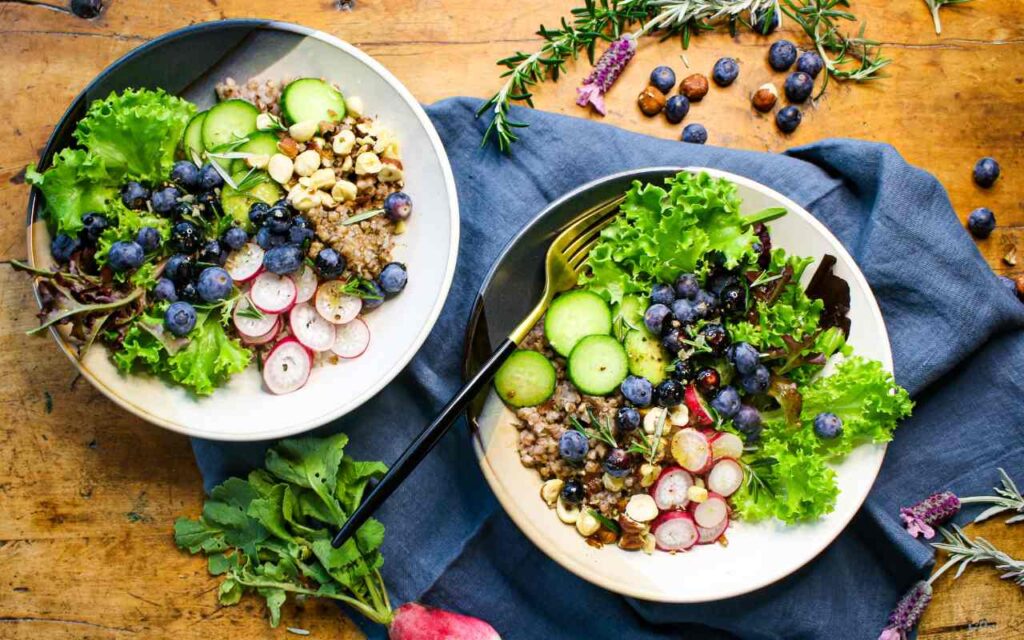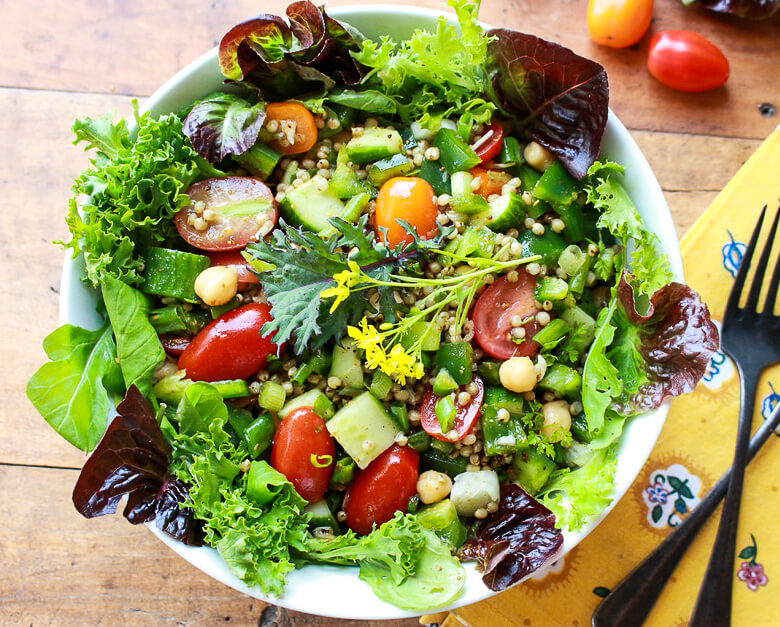Are salads healthy? They certainly can be, if you listen to the nutrition tips Sharon gives you as she answers your top questions on what to put in a salad to make it healthy.
You know the drill…when you’re trying to eat light and healthy, you often go straight to the salad menu at a restaurant, or stock your fridge with salad ingredients for lunch. But are salads healthy? Well, salads can certainly be a healthful addition to your day, but not every recipe that comes in a salad bowl meets the definition of “healthy”. That’s because that salad can be packed with a wide range of ingredients, from the healthiest (vegetables, fruits, nuts, seeds, pulses, healthy fats) to the unhealthiest (fatty cheeses, creamy dressings, processed meats, refined ingredients). So, it all depends on what you put into your salad that determines the health benefits you’ll gain from it.
When salads are prepared with a variety of vegetables, whole grains, fruits, nuts, seeds, pulses, and a flavorful vinaigrette made with healthy fats, that salad provides many nutritional benefits such as fiber, plant proteins, vitamins, minerals, healthy carbs and fats, and phytochemicals, thus it can help promote good nutrition and disease prevention. Win! Better yet is that salads can be balanced with all of the elements you need for a healthy, satisfying meal: proteins, slow-digesting carbs, and healthy fats.
However, all salads are not created equal. Some common salad toppings, like cheeses, processed and red meats, and creamy dressings can be high in saturated fat, sodium, sugar, and calories that can quickly diminish the healthfulness of your salad. So, if it’s the ingredients in salads that determines how nutritious and healthy they are, what are the best ingredients to use in your salad?
Keep reading as I answer your top questions on what you can toss into your salad to boost the nutritional benefits of your salads (and what to avoid to keep your salad light fresh and wholesome).

Ask Sharon: What to Put in a Salad To Make it Healthy?
Q What is a salad?
A The traditional definition of a salad is a cold dish containing mixtures of raw or cooked vegetables with a dressing. However, that definition has expanded over recent years to include warm foods, fruits, grains, and protein sources as salad ingredients, and the salads can be made into bowls. Salads can indeed be the main event of your meal. In my opinion, a salad should have some crunchy combo of vegetables in it and be served with a flavorful dressing. Beyond that, the definition of a salad can expand to include ingredients like beans, lentils, chickpeas, nuts, seeds, fruit, tofu, herbs, and much more.

Q What features of a salad make it a healthy meal option?
A The hallmark of a healthy salad is that it should contain a large number of vegetables, which are packed with nutrition for a low-calorie contribution. Consider leafy greens, as well as tomatoes, bell peppers, carrots, snow peas, radishes, cauliflower, brussels sprouts, microgreens and so much more! The salad can also have other healthy additions, such as cooked whole grains (quinoa, brown rice, sorghum), fruits (berries, dried fruit, melon), pulses (beans, lentils, chickpeas), nuts (almonds, pistachios, walnuts), seeds (sunflower, chia, sesame), and healthy vinaigrettes featuring vinegar, citrus juice and EVOO. This formula for a healthy salad means it is rich in fiber, vitamins, minerals, and phytochemicals. Thus, a healthy salad like I’ve described can be a far better choice than a fatty sandwich or greasy burger for a meal. These kind of balanced salads are also very satisfying, because of their texture and fiber content.

Q Are all salads healthy just because they’re called “salads?”
A No, not all salads could be called healthy! Just the word “salad” may make a menu item sound healthy, but many salads at restaurants can be filled with heavy creamy dressings, refined ingredients, sugars, and fatty meats and cheeses. Some salads have more calories, sugar, sodium, and saturated fat than other common menu options, like sandwiches or traditional meal plates. So don’t be tricked into thinking your salad option is automatically the healthiest thing on the menu! If you have a greater amount of decadent toppings (cheese, ham, creamy dressings) on your salad than nutritious toppings (veggies, fruits, nuts, seeds, beans), then it’s a good sign your salad bowl has not achieved its full health potential. Do a little homework before dining out to find the best salad restaurants in your community, as well as the best restaurant salad on the menu.

Q What are some qualities to look for in salad ingredients?
A You want to make sure you’re including healthful, nutrient-rich ingredients that are also low in saturated fat, sodium, and sugar. Think starting with a nutritious leafy green, such as kale, spinach, romaine, cabbage, or arugula. Then make sure to include at least a few different colorful vegetables, such as carrots, peas, bell peppers, tomatoes, cucumbers, onions, and broccoli. Add a plant protein, such as tofu, tempeh, seitan, chickpeas, peanuts, pistachios, or pumpkin seeds. And then top it with a light vinaigrette made with EVOO. Extra credit for tossing in some fruit and herbs.

Q What are some qualities to look out for in salad ingredients?
A You want to avoid too much sodium, saturated fat, calories, and sugar in your salad. So avoid ingredients like red or processed meat (ham, bacon, sausage, pepperoni), cheeses, processed grains (white rice, croutons made with white bread), and high-saturated fat creamy dressings (i.e., blue cheese dressing) or prepared dressings (keep an eye out for processed dressings that are high in sugar and salt).

Q What are your recommendations for the best salad ingredients out there?
A Start with deep green leafy vegetables as your base, as they are very rich in numerous vitamins and minerals, as well as phytochemicals that support health.
Pulses, like beans, chickpeas, and lentils as your fiber-rich protein source (also low in saturated fat). These support a plant-based diet linked with multiple health benefits, including healthy weight, heart, and blood glucose levels. Just open the can and dump.
Nuts and seeds for heart-healthy fats and protein. Just a sprinkling is all you need to add crunch and good taste, but also heart health benefits associated with nuts/seeds consumption. Go with the seasons and vary your salad with a mixture of veggies that are in season for a range of vitamins, minerals, and phytochemicals. Fitting in more vegetables is linked with health benefits. So, try summer squash, tomatoes, and eggplant in summer; winter squash in the fall; broccoli/cauliflower in winter; and asparagus in the spring, for example. Whole grains (quinoa, brown rice, farro, sorghum) can make your salad into a balanced meal, as these slow-digesting carbs can offer energy, vitamins, and minerals to your day and reduce your risk of chronic diseases.

Q What are the worst salad ingredients out there?
A Creamy, high-fat dressings, such as Bleu Cheese dressing, which can be high in sodium and saturated fats. Processed meats, such as bacon, ham, sausage, and pepperoni, which are high in saturated fat and sodium, should also be avoided in the diet to reduce the risk of chronic disease. Finally, high saturated fat cheeses, which increase the saturated fat levels in the diet, thus increasing your risk of heart disease should be avoided as salad ingredients.

Q How should people approach salads?
A Salads can be a healthful meal, or a not-so-healthful meal, it’s all about loading it with nutrient-rich ingredients. Make it colorful, with a delightful texture, taste, and aroma with your ingredient choices. It will be a delicious satisfying meal with all of the health potential, too.
Check out some of my favorite healthy salad recipes here:
Sicilian Purslane Salad
Sea Bean Caesar Salad
Beautiful Flower Salad with Rose Vinaigrette
Soba Noodles Seaweed Salad
Shawarma Bulgur Salad Bowl with Black Chickpeas
And read more of my Ask Sharon features, where I address your top nutrition questions at The Plant-Powered Dietitian:
How Do I Get Vegan Calcium Sources?
What are Common Nutrition Issues for Plant-Based Diets?
What are the Best Supplements for a Vegan Diet?
Are There Benefits for the AIP Diet?

